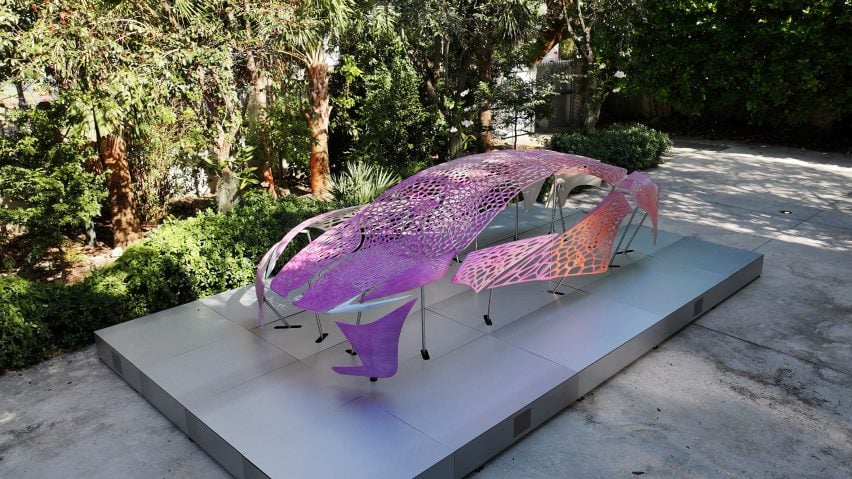Design studio Crafting Plastics has created a kinetic, car-shaped structure from 3D-printed bioplastics for Lexus based on the brand’s AI-driven software that integrates multi-sensory elements into the driving experience.
Displayed at the ICA Miami as part of the city’s art week, the Liminal Cycles installation features a skeletal representation of the all-electric Lexus LF-ZC model made of Crafting Plastics’s Nuatan bioplastic, as well as three neighbouring sculptures that explore different senses and elements of a vehicle.

It interpreted SDVs (Software Defined Vehicles), an in-development software from Lexus that aims to enhance a driver’s experience through the integration of multi-sensory design, such as personalising smell, haptics, and lighting for an individual.
In the case of electric vehicles, this might mean using a surge of interior lighting and specific tones to demonstrate the sensations of a “performance” vehicle, similar to how the smell and sound of an engine revving are traditionally associated with high performance.

“For example, when it comes to the five senses within the car – especially with the electrified vehicle – sometimes we have to consider what is the alternative stimuli replacing the engine sound and engine smells,” Calty Design Research chief designer Sellene Lee told Dezeen.
“So in an electrified vehicle, we don’t have those things, but [the user] still wants this kind of exciting vehicle, and we want to offer that kind of experience for our users.”

Crafting Plastics explored this concept with its Liminal Cycles installation by integrating sound, lighting, material responsiveness and movement into its various sculptures.
The central piece represents an LF-ZC is made of kinetic panels of the 3D-printed Nuatan bioplastic covered in a reactive coating that changes colour depending on its exposure to UV.

The panels are motion-activated and respond to passerby, expanding and contracting to create a “breathe-like” movement to reflectic the organic nature of their materiality, according to Crafting Plastics co-founder Vlasta Kubušová.
“Since all these materials are made from natural resources, we wanted to show their origin of nature and [that] they will become a part of nature when they are decomposed.”
Building upon their work with bioplastics, Kubušová also noted the installation was the first time they used the Nuatan material with a large-scale 3D printer in the exploration of producing the material at a larger scale.
“It could be [used] for everything from big interior pieces to even facades,” Kubušová told Dezeen. I think 3D printing is definitely the technology of the future, because it can be customized, but you can also do mass-produced with this technology and it doesn’t leave any waste.

Three other sculptures explore senses such as touch and smell, such as a “flower-like” sculpture representative of a steering wheel that when touched, generates fluctuations in the installation’s sound composition and seating that emanate a “Lexus-inspired” scent.
The installation also showcased objects from designers Suchi Reddy, Michael Bennett, Germane Barnes and Tara Sakhi, who were tasked with creating a vessel for an exclusive candle made in collaboration with Lexus and Philadelphia product brand Dilo.
Previously designer Marjan van Aubel created an installation for the car brand from photovoltaic panels. This year Crafting Plastics showcased their UV reactive material at Milan design week.
Liminal Cycles is on display at the ICA Miami for the Miami art week. See Dezeen Events Guide for an up-to-date list of architecture and design events taking place around the world.
The photography is by Steve Benisty

